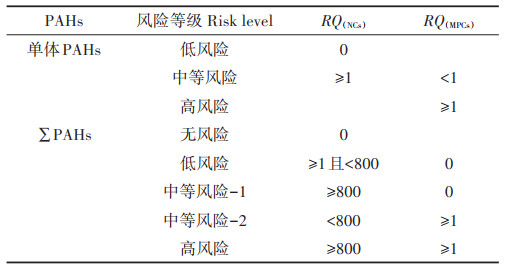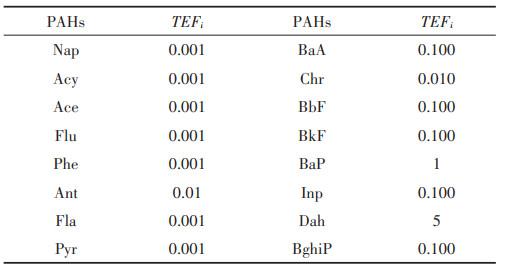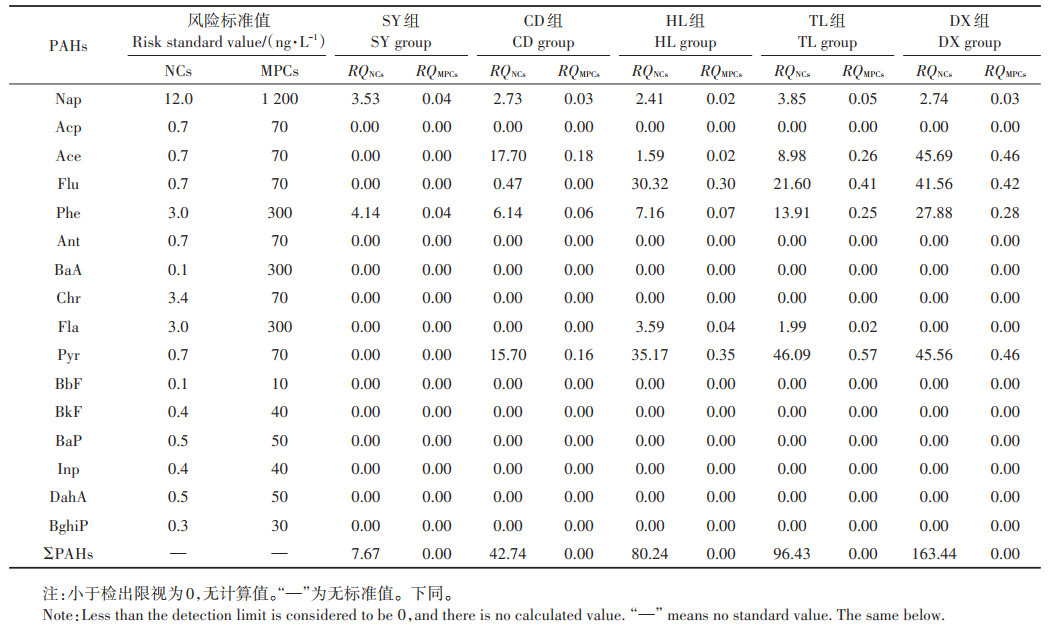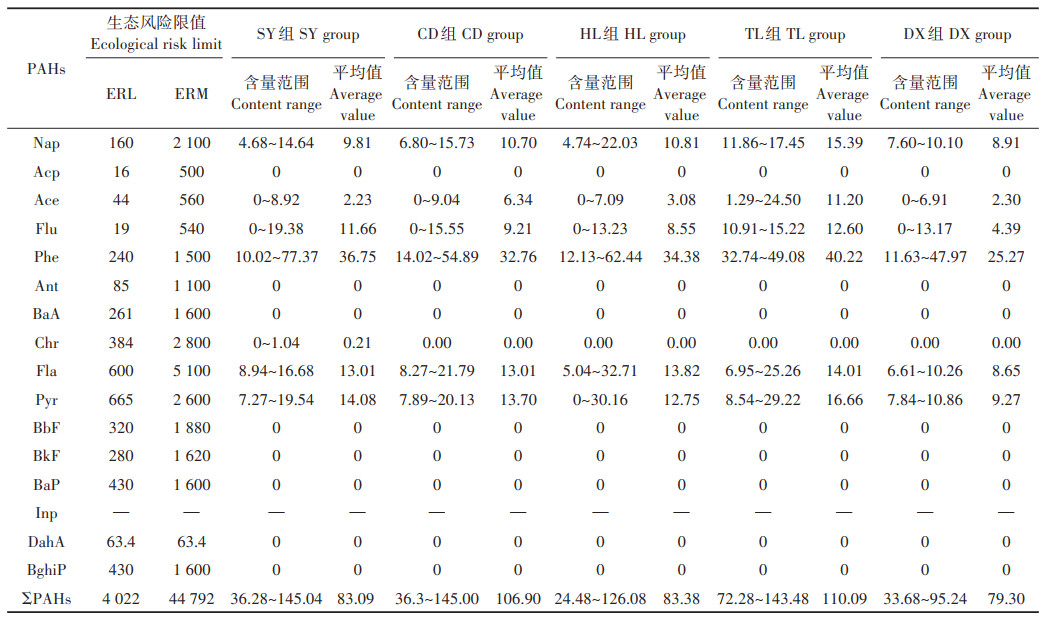2. 江苏省水产质量检测中心/农业农村部渔业产品质量监督检验测试中心 (南京), 南京 210017
2. Fishery Analysis & Testing Center of Jiangsu Province/Quality Control & Inspection Center for Domestic Fishery Products, Ministry of Agricultural and Rural Affairs(Nanjing), Nanjing 210017, China
多环芳烃(Polycyclic aromatic hydrocarbons,PAHs)指分子中含有两个以上苯环的碳氢化合物,是一类典型的持久性有机污染物,可以在环境中持久存在,难以降解。目前有150余种PAHs,其中16种被美国环保局(USEPA)列为优先控制的污染物[1-3]。该类化合物能够通过多种途径(如废水排放、大气沉降、地表径流及原油泄漏等)进入水体[4]。由于鱼类处于水生态系统食物链的顶端,水环境中的PAHs能通过鱼的鳃、皮肤或饲料等途径进入鱼体内累积,进而导致人类食用后具有一定的健康风险[5]。水体沉积物被认为是PAHs的最终归宿之一,富集在沉积物中的PAHs可通过食物链传递给高营养级生物,通过再悬浮作用释放到环境中,从而造成“二次污染”[6-7]。因此研究水产品及养殖环境中水体和沉积物PAHs的浓度分布、污染特征及其健康风险与生态风险具有重要意义。目前研究主要集中在水体和水产中PAHs的含量和风险评估[5, 8-10],或沉积物及水产中PAHs的残留与风险分析[7, 11],如张光贵[7]、王晓迪等[8]分别研究了大通湖表层沉积物和大庆湖泊群水体、淡水鱼含量及生态风险。由于水体的受污染程度与地区经济发展水平密切相关,目前大部分地区的水体都不同程度地受到PAHs的污染[12-13]。江苏属于东部沿海经济较发达地区,目前PAHs主要研究领域在长江太湖等热点水域,对江苏重点水产品养殖区污染监测较少,以渔业养殖环境(水体、水产品、底泥)作为研究方向的则更少,因此本文以江苏重点水产品养殖区为研究对象。斑点叉尾鮰属于鮰科鱼类[14],是我国斑点叉尾鮰产业的主要品种[15],鉴于近两年来商品鮰产品在营养和市场消费方面的优势,斑点叉尾鮰国内消费市场被逐步打开,带动斑点叉尾鮰养殖形势逐年向好。2019年,江苏斑点叉尾鮰主养区的斑点叉尾鮰池塘精养面积约6 667 hm2,产量达到1 400 t[16],因此选用斑点叉尾鮰典型养殖区具有较强的地域代表性。本研究根据生长周期分3次(3月、7月、10月)采集2020年江苏典型斑点叉尾鮰5个养殖区水体、底泥、斑点叉尾鮰样品,测定PAHs含量,探明其污染现状及污染特征,并对水体和底泥进行生态风险评估,对斑点叉尾鮰样品进行食用健康风险评价,以期为养殖区PAHs污染防治提供基础资料,这对保障食品安全、科学防范健康风险具有指导作用。
1 材料与方法 1.1 仪器与设备采集设备:多参数水质分析仪(美国YSI);柱状采泥器(北京普雷德仪器设备有限公司)。主要前处理设备:GPC-ULTR GPC凝胶净化浓缩系统(德国LC tech公司);R-81脂肪测定仪、R-200旋转蒸发仪(瑞士步琦公司);TurbovapⅡ全自动浓缩工作站(英国Caliper公司)。样品分析设备:Agilent7890A/5975C气相色谱-质谱联用仪(美国Agilent公司)。
1.2 标准品16种PAHs混合标准品[萘(Nap)、苊(Ace)、苊烯(Acy)、芴(Flu)、菲(Phe)、蒽(Ant)、荧蒽(Fla)、芘(Pyr)、苯并[a]蒽(BaA)、苗屈(Chr)、苯并[b]荧蒽(BbF)、苯并[k]荧蒽(BkF)、苯并[a]芘(BaP)、茚酚[1,2,3-cd] 芘(Inp)、二苯并[a,h]蒽(DahA)和苯并(g,h,i)苝(BghiP),200 mg·L-1,购自农业农村部环境保护科研监测所];内标苝-d12 4.0 mg·L-1、苊-d10 4.0 mg·L-1、菲-d12 0.2 mg·L-1、苗屈-d12 4.0 mg·L-1(美国Accustandard公司)。
1.3 样品采集、制备及前处理 1.3.1 样品采集选取5个示范基地(图 1),根据生长周期分3次(3月、7月、10月)采集同一池塘样品,每个养殖场根据池塘数采集1~2个样品,共计72个样品。采样信息见表 1。
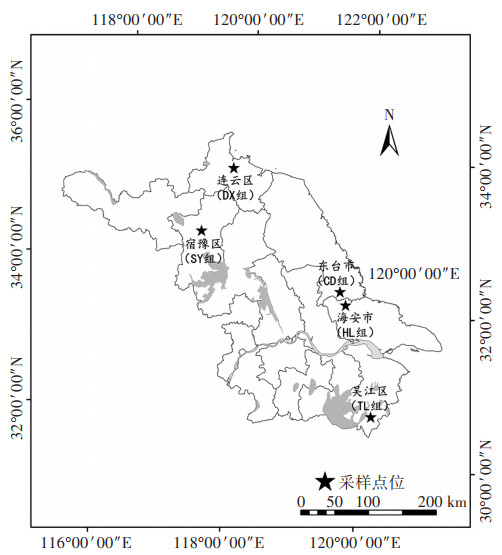
|
图 1 采样点分布图 Figure 1 Sampling location distribution diagram |
|
|
表 1 采样地点及经纬度 Table 1 Sampling location, longitude and latitude |
鱼体:每个样点采集斑点叉尾鮰鱼样若干(至少3条),取可食部分约200 g,用高速万能粉碎机制成鱼糜,冷冻贮存,供前处理使用。
水样:每个样点采集2 L水样,过0.45 μm孔径玻璃纤维滤膜,去除悬浮物,待前处理。
底泥:每个样点抽取池塘底泥2 kg(池塘对角线平均取3点),用金属抓斗式采样器采集池塘底表层沉积物样品,带回实验室后经过自然风干、均一,研磨过0.15 mm孔径(100目)铜筛,待前处理。
1.3.3 样品前处理水样前处理:用C18固相萃取柱(6 mL,0.5 g,美国Supelco公司)萃取PAHs,将萃取柱带回实验室进行洗脱与分析。鱼体、底泥参照徐志华等[17]关于渔业养殖环境及水产品中16种PAHs测定方法,气相色谱- 质谱联用仪上机检测。
1.4 标准溶液及质量控制标准溶液:使用正己烷配制成含16种PAHs浓度为1.0、5.0、25.0、50.0、100、250 μg·L-1,内标浓度为100 μg·L-1的标准溶液,以标准溶液中被测组分峰面积和内标物质峰面积的比值为纵坐标,标准溶液中各种PAHs的浓度和内标物质浓度的比值为横坐标[17-18]。
质量控制:取同批次的底泥、养殖用水、斑点叉尾鮰,分别加入1.0 μg·kg-1混合标准溶液,每个浓度设置6个平行。加标及相对偏差分别为:底泥52.4%~ 110.7%、0.64%~8.94%;养殖用水74.1%~116.7%、0.52%~8.91%,水产品70.3%~126.4%、0.14%~8.91%;平均检出限为0.017~0.171 μg·kg-1 [17-18]。
1.5 仪器工作条件色谱条件:DB35-MS(30 m×0.25 mm,0.25 μm);进样口温度260 ℃;载气为99.999% 高纯氮气;不分流进样,进样量1 μL;流量1.0 mL·min-1;柱升温程序:初始温度70 ℃(1 min),15 ℃·min-1升至190 ℃(1 min),25 ℃·min-1升至200 ℃;5 ℃·min-1升至230 ℃(4 min),2.5 ℃·min-1升至250 ℃(3 min),2 ℃·min-1升至280 ℃(3 min),20 ℃·min-1升至310 ℃(2 min)[17-18]。
质谱条件:EI源;离子源温度160 ℃;四极杆温度150 ℃;传输线温度280 ℃;选择离子检测(Selected ion recording,SIM)模式;各种PAHs及内标物的定性、定量离子参考文献[17-18]。
GPC条件:TACS TM系统参数:油浴温度40 ℃,流速5.0 mL·min-1,样品定量环5 mL,前运行时间1 140 s,主运行时间2 000 s,后运行时间120 s,真空参数:阶段1为17 kPa,阶段2为21 kPa,后运行时间120 s[17-18]。
1.6 生态风险评价方法 1.6.1 池塘水体生态风险评价根据国内外学者研究实际情况与生态风险评价方法,本文参考KALF等[19]和TONGO等[20]的研究,采用风险商法(商值法)进行生态风险评价,该方法具有可操作性强和结论明确的特点[21]。

|
(1) |

|
(2) |

|
(3) |
16种PAHs总的风险商值公式如下:

|
(4) |

|
(5) |

|
(6) |
式中:RQ为风险商值;CPAHs为水体中某PAHs单体浓度,ng·L-1;CQV为水体中某PAHs单体的风险标准值,ng·L-1;CQV(NCs)为最低风险标准值,ng·L-1;CQV(MPCs)为最高风险标准值,ng·L-1;RQNCs为最低风险商值;RQMPCs为最高风险商值。生态风险等级划分见表 2。
|
|
表 2 单体PAHs和∑PAHs生态风险等级划分 Table 2 Risk classification of individual of PAHs and total PAHs |
采用沉积物质量基准法(SQGs)对底泥中PAHs生态风险开展评价。根据LONG等[22]和张嘉雯等[23]提出的沉积物中有机污染物潜在生态风险效应区间低值(Effects range low,ERL)和效应区间中值(Effects range median,ERM),当污染物含量小于ERL时,对生物毒副作用不显著(风险几率 < 10%);当污染物含量大于ERM时,对生物会产生毒副作用(风险几率> 50%),可能会产生一定的负面生态效应;当污染物含量在ERL与ERM之间时(风险几率介于10%~50%),偶尔会产生负面生态效应[23-24]。
1.7 斑点叉尾鮰消费健康风险评价采用美国环保局(USEPA)推荐的终生致癌风险(Incremental life time cancer risk,ILCR)模型评价斑点叉尾鮰消费健康风险[25]。

|
(7) |

|
(8) |
式中:n=16;Ci为PAHs组分i在斑点叉尾鮰样品中的浓度,ng·kg-1;TEFi为组分i的BaP毒性当量因子(表 3);ILCR为PAHs在某剂量下的人群终生致癌风险;TEQBaP为PAHs相对于BaP的等效致癌毒性,ng · kg-1;DR为每日的摄入量,根据江苏省统计局2019统计年鉴[26]中的鱼类日均消费量及中国渔业统计年鉴[16]中的斑点叉尾鮰产量、鱼类产量,估算取值为1.92×10-3 kg·d-1,SF为BaP的致癌风险系数经口暴露数值,7.3 kg·d-1·mg-1;CF为转换系数,10-6 mg· ng-1;EF为每年暴露天数,取值为365 d;BW为成人人均体质量,kg,取值为61.5 kg[27];AT为人群的预期寿命,a,根据国家统计局数据[28]取值为76 a;ED为暴露年数,非致癌物取30 a,致癌物取70 a;AT为人的预期寿命,对于非致癌物取30 a(10 950 d),对于致癌物取70 a(25 550 d)。
|
|
表 3 PAHs的BaP等效因子 Table 3 Toxic equivalent factors(TEFs)of PAHs |
使用Excel 2007、Origin 2018、ArcGIS 10.7进行数据处理和制图。
2 结果与讨论 2.1 典型养殖池塘中斑点叉尾鮰、池塘水体、底泥PAHs的含量及特征本文对5个主养殖区进行了16种PAHs组分检测,总检出率为100%,在鱼体、养殖水体、底泥中,PAHs单体Nap、Phe、BaA、Pyr、Chr、Flu、Ace为常见检出物,其中Phe在各组别中均有检出,检出率达100%,Nap达到80% 以上。菲是主要的污染物,但致癌性物质苯并[a]芘均未检出。从不同组别来看,5个典型养殖区养殖环境均远离工业区及城市主要生活区,鱼体、水体、池塘底泥总PAHs含量无明显差异(表 4)。
|
|
表 4 各养殖区典型池塘中斑点Ictalurus punctatus叉尾鮰、池塘水体、底泥中16种PAHs含量 Table 4 Concentrations of 16 species PAHs in Ictalurus punctatus pond water, sediment of different aquaculture areas |
鱼体中总PAHs含量范围在11.8~60.0 μg·kg-1(以湿质量计,下同),整体来说,养殖区斑点叉尾鮰PAHs含量较低,受污染程度较轻。不同鱼品种的富集能力不同,长江下游江段7种不同鱼体含量43.4~ 113.1 μg·kg-1[13],其同一流域鳜鱼、鲤鱼含量分别为43.42、67.70 μg·kg-1。
池塘养殖水总PAHs含量范围在0.03~0.46 μg· L-1,同为江苏水域的太湖流域1月、7月地表水中总PAHs的浓度均值分别为1.380、0.054 μg·L-1[29],长江流域含量为0.033 μg·L-1[30],与本研究结果具有一致性。环境中大多数PAHs与人为来源排放有关,与水域、地域具有很强关联性,七大流域水系中,珠江流域高于长江流域[30]。谢文平等[10]调查的广东地区罗非鱼养殖水体PAHs含量平均值为0.27 μg·L-1,范围为0.053~0.680 μg · L-1,鱼体含量为36.53~143.44 μg · kg-1,水体、鱼体含量较本研究含量略高。
池塘底泥总PAHs含量在24.48~145.04 μg·kg-1(以干质量计,下同),根据欧盟规定,土壤中总PAHs的浓度小于200 μg·kg-1为未污染,200~600 μg·kg-1为轻度污染[31],可见养殖区底泥污染程度属于未污染。淮河干流沉积物中PAHs平均含量为143.30 μg · kg-1[32],骆马湖表层沉积物总量范围在189.2~725.9 μg·kg-1,处于低-中等污染水平[33]。马万里[34]研究表明,总体上我国土壤PAHs污染程度较轻。
进一步分析单体PAHs,如Nap主要源于原油及原煤的燃烧[35],Pyr、Phe、Fla可作为煤炭燃烧指示物[36],表明环境中存在原油、煤炭等污染来源。因此,从单体来源上可推测养殖区PAHs污染来源主要为石油、煤炭燃烧。
2.2 养殖池塘中斑点叉尾鮰、池塘水体、底泥PAHs结构组成特征根据PAHs结构差异,可以将PAHs分为低环(2~ 3环)、中环(4环)、高环(5~6环)。对5个主要养殖区PAHs结构进行分析,发现斑点叉尾鮰鱼体、养殖水体以2~4环为主要成分,5环以上未检出(低于检出限)。其中水体中低环PAHs含量高于高环;底泥结构较为复杂,以3~4环为优势组分,底泥中低环PAHs与高环PAHs含量比值较水体中低(图 2)。
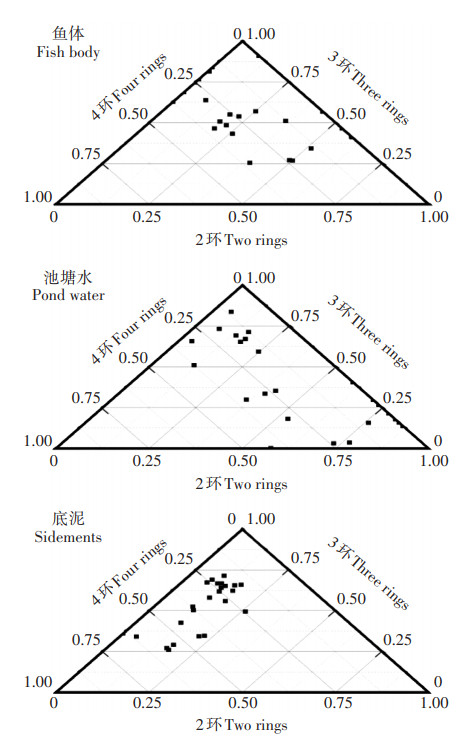
|
图 2 各养殖区斑点叉尾鮰、池塘水体、底泥不同环数PAHs所 Figure 2 Triangle chart of PAHs proportion of different ring number in Ietalurus punetaus, pond water, and sediment |
由于PAHs在鱼体内累积程度与其水环境中的背景浓度相一致[37],鱼体和水体在PAHs结构上也具有相似性,以中低环为主。汪红军等[5]调查了汉江下游水样及相应江段典型鱼鱼体,发现PAHs结构组成呈现以低中环为主、高环最低的规律,秦宁等[9]对巢湖水体的研究也得出巢湖水体PAHs以低环和中环为主的结论。
养殖区池塘水体与底泥PAHs结构不同,分析发现底泥PAHs结构更为复杂,以3~4环作为优势组分,且底泥中低环PAHs与高环PAHs含量比值较水体中低。底泥结构不同可能是因为水体低环PAHs的产生来源比高环PAHs广泛,且高环PAHs的疏水性较强,与之相比,低环PAHs在水体中的溶解度较高,最终导致水体中低环PAHs浓度较高[38-39]。而底泥中低环PAHs与高环PAHs含量比值较水体中低,是因为高环PAHs在水中的溶解度较小,促使高环PAHs从水相中分配到生物体内或底泥中,且微生物只能利用吸收底泥液相中的有机物,而难以利用固相中的有机物,这造成4环或4环以上的PAHs难以被生物降解而在底泥中累积[39],从而呈现低环浓度较低的结果。
通常认为不同分子量PAHs的相对丰度可以反映其来源[37],一般4环以下的低分子量PAHs主要来源于石油类污染及木材、煤等在低至中温范围内的燃烧,4环以上高分子量的PAHs主要来源于化石燃料的高温燃烧,从环数结构上进一步验证了本文养殖区PAHs污染来源主要是石油类污染及木材、煤低、中温燃烧[38]。
2.3 风险评价 2.3.1 水体生态风险评价据PAHs的风险等级划分(表 2),结合养殖区池塘水体PAHs的RQ值(表 5)发现,主要养殖区池塘水体总PAHs最高风险标准值(RQMPCs)为0,最低风险浓度风险商值(RQMPCs)小于800,表明生态风险为低风险程度,各单体产生的生态风险均未达到严重生态风险水平。其中Nap、Phe以及部分池塘中Ace、Pyr、Fla的RQNCS大于1,而RQMPCs小于1,说明这些单体PAHs处于中等风险水平,需要进一步研究相应控制和修复措施;其余单体PAHs的RQNCS小于1,对生态系统的影响可以忽略。江苏主要水域中,太湖流域地表水中PAHs造成的生态风险较小[29];长江中下游支流水体中未发现生态系统风险,除DahA单体外,其余单体PAHs造成的污染可列为中等水平[40]。郭广慧等[41]研究了中国七大流域地表水系,也得出了部分如单体Bap、Ant、Flua和Pyr对水生生物具有潜在的生态风险的结论。因此从长期的环境暴露角度出发,应采取一定的控制措施,以降低PAHs的生态风险。
|
|
表 5 主要养殖区池塘水体PAHs的RQNCS和RQMPCs Table 5 RQNCS and RQMPCs of PAHs in ponds of main aquaculture area |
采用效应区间低、中值法(ERL/ERM)对各个主要养殖区池塘表面沉积物中PAHs进行生态风险评价。据表 6中风险评价标准得出沉积物中生态风险值可知,各个主要养殖区各单体PAHs和PAHs总量最高值都低于ERL,总体上表明PAHs对生物毒副作用不显著(风险几率 < 10%)。分析斑点叉尾鮰5个主要养殖区的数据,整体上PAHs均有检出,检出率为100%,以Nap、Pyr、Phe、Fla等单体PAHs在池塘底泥环境中检出率较高,经过计算,发现单体PAHs的生态风险值较小,但环境中长期存在的PAHs仍然可能会对生物产生毒副作用。查阅江苏相关流域沉积物资料,发现太湖总体不存在严重的PAHs生态风险,局部点位芴、菲可能具有一定的生态风险[42];淮河干流沉积物中PAHs平均含量远低于潜在生态风险的效应区间低值ERL(风险几率 < 10%),极少产生负面效应[32],与本文结果一致。
|
|
表 6 主要养殖区池塘表面沉积物中PAHs生态风险评价(μg·kg-1) Table 6 Ecological risk assessment of PAHs in surface sediments of ponds in main aquaculture areas(μg·kg-1) |
根据USEPA规定,可接受的致癌风险为小于10-6 a-1,风险大于10-4 a-1则被认为具有较高的风险性。ILCR模型计算结果显示,成人的PAHs终生致癌风险范围为2.25×10-9~5.80×10-7 a-1(表 7),说明主要养殖区斑点叉尾鮰样品的致癌风险远小于可接受水平,处于致癌风险控制水平。从组别上分析,5个斑点叉尾鮰养殖区中,SY组、CD组相对其余3个养殖区致癌风险更小,整体上各组别差异较小。汉江下游鱼类食用健风险水平在8.00×10-7~2.08×10-6 a-1,有潜在风险[4];广东罗非鱼主要养殖区罗非鱼肌肉中8种非致癌PAHs的总非致癌风险为2.51×10-10~1.54×10-9 a-1,6种致癌PAHs造成个人年致癌风险值范围为2.87×10-6~ 1.56×10-5 a-1[10]。这一方面表明江苏主要养殖区食用斑点叉尾鮰健康风险水平较小,另一方面也说明各地方食用鱼的健康风险水平也有差异,可能是由于鱼类食性、年龄、个体大小等存在差异,导致不同鱼对PAHs的富集因子也不同[5]。
|
|
表 7 各养殖区PAHs基于BaP的毒性当量和终生致癌风险 Table 7 Toxic equivalence and lifelong carcinogenic risk of PAHs based on BaP in main aquaculture areas |
健康风险评价的一个重要特征是在整个评价过程中的每一步都存在着一定的不确定性[2]。本文主要讨论了从生长阶段到成鱼阶段的成人可食用健康风险,而没有考虑个体对污染物的吸收和利用能力,如果想要更加准确地估计健康风险,还需要考虑人群生理因子参数、人群行为因子参数、易感程度等。因此,本研究评价结果具有不确定性[2]。
3 结论(1)16种PAHs组分在5个主要养殖区的总检出率为100%,PAHs单体在鱼体、养殖水体、底泥中,Nap、Phe、BaA、Pyr、Chr、Flu、Ace为常见检出物,其中Phe检出率达100%,Nap达到80% 以上。鱼体中总PAHs含量范围在11.75~60.02 μg·kg-1,池塘养殖水含量范围在0.03~0.46 μg·L-1,底泥含量在24.48~145.04 μg·kg-1。PAHs结构组成上,斑点叉尾鮰、养殖水体以2~4环为主要成分,底泥结构较为复杂,以3~4环为优势组分。5个斑点叉尾鮰养殖区含量差别较小,未发现明显差异性。
(2)养殖水体中PAHs生态风险程度为低风险,Nap、Phe及部分池塘中Ace、Pyr、Fla处于中等风险水平,其余单体对生态系统的影响可以忽略。池塘底泥环境中,各单体PAHs和PAHs总量最高值都低于潜在生态风险效应区间低值,PAHs对生物毒副作用不显著。但Nap、Pyr、Phe、Fla等单体PAHs在池塘底泥环境中有检出,还需加以重视,加强监测与防控。
(3)斑点叉尾鮰食用健康风险评价结果表明,成人的终生致癌风险范围为2.25×10-9~5.80×10-7 a-1,养殖区斑点叉尾鮰样品的致癌风险远小于最大可接受水平,处于致癌风险控制水平。
| [1] |
薛佳. 环境样品中16种多环芳烃分析方法研究[J]. 福建地质, 2012, 31(4): 358-367. XUE J. The study on the analysis method for 16 polycyclic aromatic hydrocarbons(PAHs) in environmental samples[J]. Geology of Fujian, 2012, 31(4): 358-367. DOI:10.3969/j.issn.1001-3970.2012.04.008 |
| [2] |
夏文迪. 多环芳烃(PAHs)人体内暴露剂量与致癌风险研究[D]. 长沙: 中南大学, 2014. XIA W D. Internal exposure dose and cancer risk assessment of polycyclic aromatic hydrocarbons(PAHs) in human body[D]. Changsha: Central South University, 2014. |
| [3] |
孙福生, 陈大力, 姚盛华, 等. 固相萃取液相色谱测定水中16个多环芳烃(Ⅱ)——水中USEPA16个多环芳烃的测定[J]. 苏州科技学院学报(工程技术版), 2006, 19(4): 43-48. SUN F S, CHEN D L, YAO S H, et al. Determination of 16 polycyclic aromatic hydrocarbons by liquid chromatography with solid phase extraction(Ⅱ): Determination of US environmental protection agency 16 polycyclic aromatic hydrocarbons in water[J]. Journal of University of Science and Technology of Suzhou: Engineering and Technology, 2006, 19(4): 43-48. |
| [4] |
HEEMKEN O P, STACHEL B, THEOBALD N, et al. Temporal variability of organic micropollutants in suspended particulate matter of the River Elbe at Hamburg and the River Mulde at Dessau, Germany[J]. Archives of Environmental Contamination and Toxicology, 2000, 38(1): 11-31. DOI:10.1007/s002449910003 |
| [5] |
汪红军, 郑金秀, 李嗣新, 等. 汉江下游水体和鱼体多环芳烃分布特征及健康风险[J]. 水生态学杂志, 2016, 37(6): 51-58. WANG H J, ZHENG J X, LI S X, et al. Distribution characteristics and health risk of polycyclic aromatic hydrocarbons in water and fish in the lower reaches of Hanjiang River[J]. Journal of Hydroecology, 2016, 37(6): 51-58. |
| [6] |
汤智, 廖海清, 张亮, 等. 成渝经济区河流表层沉积物中多环芳烃的分布、来源及生态风险评价[J]. 环境科学, 2011, 32(9): 2639-2644. TANG Z, LIAO H Q, ZHANG L, et al. Distribution, source and risk assessment of polycyclic aromatic hydrocarbons in river sediment of Cheng -Yu economic zone[J]. Environmental Science, 2011, 32(9): 2639-2644. |
| [7] |
张光贵. 大通湖表层沉积物中多环芳烃的含量、来源与生态风险评估[J]. 水生态学杂志, 2014, 35(1): 46-49. ZHANG G G. Content, concentrations, sources and ecological risk assessment of polycyclic aromatic hydrocarbons in surface sediments from Datong Lake[J]. Journal of Hydroecology, 2014, 35(1): 46-49. |
| [8] |
王晓迪, 臧淑英, 张玉红, 等. 大庆湖泊群水体和淡水鱼中多环芳烃污染特征及生态风险评估[J]. 环境科学, 2015, 36(11): 4291-4301. WANG X D, ZANG S Y, ZHANG Y H, et al. Pollution characteristics and ecological risk assessment of PAHs in water and fishes from Daqing Lakes[J]. Environmental Science, 2015, 36(11): 4291-4301. |
| [9] |
秦宁, 何伟, 王雁, 等. 巢湖水体和水产品中多环芳烃的含量与健康风险[J]. 环境科学学报, 2013, 33(1): 230-239. QIN N, HE W, WANG Y, et al. Residues and health risk of polycyclic aromatic hydrocarbons in the water and aquatic products from Lake Chaohu[J]. Acta Scientiae Circumstantiae, 2013, 33(1): 230-239. |
| [10] |
谢文平, 朱新平, 郑光明, 等. 广东罗非鱼养殖区水体及鱼体中多环芳烃的含量与健康风险[J]. 农业环境科学学报, 2014, 33(12): 2450-2456. XIE W P, ZHU X P, ZHENG G M, et al. Health risk assessment of polycyclic aromatic hydrocarbons in water and fish from tilapia pond of Guangdong[J]. Journal of Agro-Environment Science, 2014, 33(12): 2450-2456. DOI:10.11654/jaes.2014.12.024 |
| [11] |
董军, 栾天罡, 邹世春, 等. 珠江三角洲淡水养殖沉积物及鱼体中DDTs和PAHs的残留与风险分析[J]. 生态环境学报, 2006, 15(4): 693-696. DONG J, LUAN T G, ZOU S C, et al. Residue and risk analysis of DDTs and PAHs in freshwater cultured sediments and fish in Pearl River Delta[J]. Acta Ecologica Sinica, 2006, 15(4): 693-696. DOI:10.3969/j.issn.1674-5906.2006.04.007 |
| [12] |
王继行. 荧蒽在水体表层沉积物中的吸附解吸特性及其净水去除对策初探[D]. 重庆: 重庆大学, 2013. WANG J X. Sorption and desorption characteristics of fluoranthene to surface sediment and preliminary discussion on removal countermeasure on water purification[D]. Chongqing: Chongqing University, 2013. |
| [13] |
王军帅, 钱卓真, 吴萍萍, 等. 水产品中多环芳烃的污染和健康风险评价模型研究进展[J]. 渔业研究, 2015, 37(1): 79-88. WANG J S, QIAN Z Z, WU P P, et al. Research progress of pollution and health risk assessment model for polycyclic aromatic hydrocarbons in aquatic products[J]. Fujian Agriculture and Forestry University, 2015, 37(1): 79-88. |
| [14] |
韦艳, 祭仲石, 李传慰, 等. 斑点叉尾鮰养殖与病害防治技术[J]. 渔业致富指南, 2019, 512(8): 41-43. WEI Y, JI Z S, LI C W, et al. Cultivation and disease control techniques of channel catfish[J]. Fishery Guide to be Rich, 2019, 512(8): 41-43. |
| [15] |
代云云, 袁永明, 袁媛, 等. 中国鮰鱼产业发展现状及趋势分析[J]. 湖南农业科学, 2019, 401(2): 97-100. DAI Y Y, YUAN Y M, YUAN Y, et al. Development status and trend analysis of channel catfish industry in China[J]. Hunan Agricultural Sciences, 2019, 401(2): 97-100. |
| [16] |
农业农村部渔业渔政管理局. 2020中国渔业统计年鉴[M]. 北京: 中国农业出版社, 2020. Ministry of Agriculture and Rural Affairs of the People's Republic of China. Fisheries statistical yearbook of China 2020[M]. Beijing: China Agriculture Press, 2020. |
| [17] |
徐志华, 朱晓华, 葛筱琴, 等. 自动索氏抽提-凝胶渗透色谱-气相色谱/质谱法测定渔业养殖环境及水产品中16种多环芳烃残留量[J]. 江苏农业学报, 2019, 35(6): 1459-1467. XU Z H, ZHU X H, GE X Q, et al. Determination of 16 polycyclic aromatic hydrocarbons residues in aquaculture environment and aquatic products by automated Soxhlet extraction-gel permeation chromatography-gas chromatography/mass spectrometry mothod[J]. Jiangsu Journal of Agricultural Sciences, 2019, 35(6): 1459-1467. DOI:10.3969/j.issn.1000-4440.2019.06.027 |
| [18] |
徐志华, 朱晓华, 葛筱琴, 等. 高邮养殖区罗氏沼虾中多环芳烃的残留现状与健康风险评价[J]. 食品安全质量检测学报, 2019, 10(19): 6718-6723. XU Z H, ZHU X H, GE X Q, et al. Determination and health risk assessment of polycyclic aromatic hydrocarbons residues in Macrobrachium rosenbergii in major aquaculture areas of Gaoyou City[J]. Journal of Food Safety and Quality Inspection, 2019, 10(19): 6718-6723. |
| [19] |
KALF D F, CROMMENTULJN T, PLASSCHE J V D. Environmental quality objectives for 10 polycyclic aromatic hydrocarbons(PAHs)[J]. Ecotoxicology & Environmental Safety, 1997, 36(1): 89-97. |
| [20] |
TONGO I, EZEMEONYE L, AKPEH K. Distribution, characterization, and human health risk assessment of polycyclic aromatic hydrocarbons(PAHs) in Ovia River, Southern Nigeria[J]. Environmental Monitoring & Assessment, 2017, 189(6): 241-247, 216. |
| [21] |
赵建亮, 应光国, 魏东斌, 等. 水体和沉积物中毒害污染物的生态风险评价方法体系研究进展[J]. 生态毒理学报, 2011, 6(6): 577-588. ZHAO J L, YING G G, WEI D B, et al. Ecological risk assessment methodology of toxic pollutants in surface water and sediments[J]. Asian Journal of Ecotoxicology, 2011, 6(6): 577-588. |
| [22] |
LONG E R, MACDONALD D D, SMITH S L, et al. Incidence of adverse biological effects within ranges of chemical concentrations in marine and estuarine sediments[J]. Environmental Management, 1995, 19(1): 81-97. DOI:10.1007/BF02472006 |
| [23] |
张嘉雯, 魏健, 吕一凡, 等. 衡水湖沉积物中典型持久性有机污染物污染特征与风险评估[J]. 环境科学, 2020, 41(3): 347-357. ZHANG J W, WEI J, LÜ Y F, et al. Occurrence and ecological risk assessment of typical persistent organic pollutants in Hengshui Lake[J]. Environmental Science, 2020, 41(3): 347-357. |
| [24] |
郑曦, 姚俊华, 蒋欢, 等. 骆马湖表层沉积物中多环芳烃的分布及风险评价[J]. 安徽农业科学, 2010, 38(20): 10858-10861. ZHENG X, YAO J H, JIANG H, et al. Distribution and risk assessment of polycyclic aromatic hydrocarbons in surface sediments from Luoma Lake[J]. Journal of Anhui Agricultural Sciences, 2010, 38(20): 10858-10861. DOI:10.3969/j.issn.0517-6611.2010.20.141 |
| [25] |
NISBETI C T. Toxic equivalency factors(TEFs) for polycyclic aromatic hydrocarbons(PAHs)[J]. Regulatory Toxicology & Pharmacology Rtp, 1992, 16: 290-300. |
| [26] |
江苏省统计局. 江苏统计年鉴2019[M]. 北京: 中国统计出版社, 2019. Jiangsu Provincial Bureau of Statistics. Jiangsu statistical yearbook 2019[M]. Beijing: China Statistics Press, 2019. |
| [27] |
戴月, 甄世褀, 袁宝军. 江苏居民营养与健康状况追踪研究[M]. 南京: 南京大学出版社, 2014. DAI Y, ZHEN S Q, YUAN B J. Study on nutrition and health status of residents in Jiangsu Province[M]. Nanjing: Nanjing University Press, 2014. |
| [28] |
国家统计局. 中国统计年鉴2020[M]. 北京: 中国统计出版社, 2020. National Bureau of Statistics. China statistical yearbook 2020[M]. Beijing: China Statistics Press, 2020. |
| [29] |
李涛, 王玉, 徐枫, 等. 太湖流域地表水中多环芳烃的来源解析及风险评价[J]. 环境科学与技术, 2018, 41(11): 198-204. LI T, WANG Y, XU F, et al. Pollution characteristics, source apportionment and risk assessment of polycyclic aromatic hydrocarbons in surface water from Taihu Lake Basin[J]. Environmental Science and Technology, 2018, 41(11): 198-204. |
| [30] |
范博, 王晓南, 黄云, 等. 我国七大流域水体多环芳烃的分布特征及风险评价[J]. 环境科学, 2019, 40(5): 2101-2114. FAN B, WANG X N, HUANG Y, et al. Distribution and risk assessment of polycyclic aromatic hydrocarbons in water bodies in seven basins of China[J]. Chinese Journal of Environmental Science, 2019, 40(5): 2101-2114. |
| [31] |
MALSIZEWSK-KORDYBACH B. Polycyclic aromatic hydrocarbons in agricultural soils in Poland: Preliminary proposals for criteria to evaluate the level of soil contamination[J]. Applied Geochemistry, 1996, 11(1/2): 121-127. |
| [32] |
陈国良, 刘玲, 罗斌, 等. 淮河干流沉积物中多环芳烃含量与生态风险评价[C]//中国毒理学会环境与生态毒理学专业委员会第二届学术研讨会暨中国环境科学学会环境标准与基准专业委员会2011年学术研讨会会议论文集, 北京: 中国毒理学会, 2011. CHEN G L, LIU L, LUO B, et al. Polycyclic aromatic hydrocarbons (PAHs)content and ecological risk assessment in sediments of Huaihe River mainstream[C]//Symposium of the second academic seminar of environmental and ecotoxicology Professional Committee of Chinese Society of Toxicology and 2011 academic seminar of environmental standards and standards Professional Committee of Chinese society of environmental Sciences, Beijing: Chinese Society of Toxicology, 2011. |
| [33] |
刘抗, 郑曦, 韩宝平. 骆马湖表层沉积物中多环芳烃的源解析[J]. 江苏师范大学学报(自然科学版), 2012(6): 555-560. LIU K, ZHENG X, HAN B P. Source apportionment of polycyclic aromatic hydrocarbons in surface sediment of Luoma Lake[J]. Journal of Jiangsu Normal University (Natural Science Edition), 2012(6): 555-560. |
| [34] |
马万里. 我国土壤和大气中多环芳烃分布特征和大尺度数值模拟[J]. 哈尔滨: 哈尔滨工业大学, 2010. MA W L. Distribution characteristics and large scale numerical simulation of polycyclic aromatic hydrocarbons in soil and atmosphere of China[J]. Harbin: Harbin Institute of Technology, 2010. |
| [35] |
周婕成, 陈振楼, 毕春娟, 等. 温州城市河流中多环芳烃的污染特征及其来源[J]. 环境科学, 2012, 33(12): 4226-4236. ZHOU J C, CHEN Z L, BI C J, et al. Pollution characteristics and sources of polycyclic aromatic hydrocarbons in urban rivers of Wenzhou City[J]. Environmental Science, 2012, 33(12): 4226-4236. |
| [36] |
田大年, 党丽慧, 丁润梅, 等. 银川市湿地表层水中多环芳烃的分布, 来源及生态风险评价[J]. 环境科学, 2019, 40(7): 3068-3078. TIAN D N, DANG L H, DING R M, et al. Distribution, sources, and ecological risk assessment of polycyclic aromatic hydrocarbons in the surface waters of the Yinchuan wetlands[J]. Environmental Science, 2019, 40(7): 3068-3078. |
| [37] |
王汨, 闫玉莲, 李建, 等. 长江朱杨江段和沱江富顺江段鱼类体内16种多环芳烃的含量[J]. 水生生物学报, 2013, 37(2): 358-366. WANG M, YAN Y L, LI J, et al. Polycyclic aromatic hydrocarbons in fish from the Zhuyang section of the Yangtze River and the Fushun section of the Tuo River, China[J]. Acta Hydrobiologica Sinica, 2013, 37(2): 358-366. |
| [38] |
MACKAY D, WAN Y S, MA K C, et al. Handbook of physical-chemical properties and environmental fate for organic chemicals[M]. Boca Raton: CRC Press LLC, 2006.
|
| [39] |
宋玉梅, 王畅, 刘爽, 等. 广州饮用水水源地多环芳烃分布、来源及人体健康风险评价[J]. 环境科学, 2019, 40(8): 3489-3500. SONG Y M, WANG C, LIU S, et al. Distribution, sources, and health risk assessment of pahs in water supply source regions of Guangzhou[J]. Environmental Science, 2019, 40(8): 3489-3500. |
| [40] |
贾天琪, 雷荣荣, 武小琳, 等. 长江下游支流水体中多环芳烃的分布及生态风险评估[J]. 环境科学, 2020, 41(5): 227-234. JIA T Q, LEI R R, WU X L, et al. Distribution, sources, and risk assessment of polycyclic aromatic hydrocarbons(PAHs) in tributary waters of the lower reaches of the Yangtze River, China[J]. Environmental Science, 2020, 41(5): 227-234. |
| [41] |
郭广慧, 吴丰昌, 何宏平, 等. 中国地表水体多环芳烃含量分布特征及其生态风险评价[J]. 中国科学: 地球科学, 2012, 42(5): 680-691. GUO G H, WU F C, HE H P, et al. Distribution characteristics and ecological risk assessment of polycyclic aromatic hydrocarbons in surface water in China[J]. Scientia Sinica Terrae, 2012, 42(5): 680-691. |
| [42] |
李玉斌. 太湖水体及表层沉积物中SVOCs分布及生态风险评价[D]. 北京: 北京化工大学, 2011. LI Y B. Distribution and ecological risk assessment of SVOCs in surface sediments from Taihu Lake[D]. Beijing: Beijing University of Chemical Technology, 2011. |
 2021, Vol. 40
2021, Vol. 40




